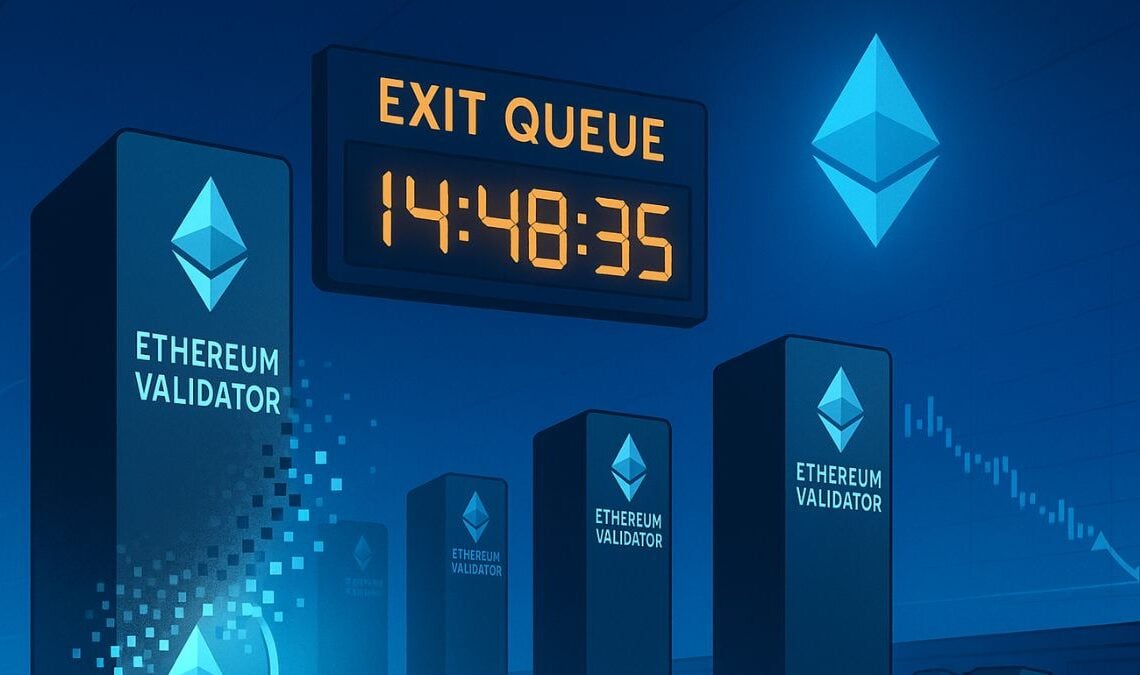The Ethereum network is under renewed scrutiny as the validator exit queue reached its highest level in 18 months, raising alarms about growing concerns within the staking community. With over 16,000 validators currently waiting to exit, the exodus could signal a major shift in sentiment toward Ethereum’s staking economy — and possibly its price trajectory.
Table of Contents
ToggleValidator Exit Spike Triggers Market Jitters
According to data from ValidatorQueue.com, the number of validators lining up to withdraw from Ethereum’s Proof-of-Stake network has surged in July, reaching levels not seen since the Shanghai upgrade in early 2023. This recent spike in validator exit requests has placed pressure on Ethereum’s price, which has dropped nearly 5% over the past week.
Source: ValidatorQueue.com
The queue currently stands at over 16,300 validators, according to Everstake, a major Ethereum staking service provider. Each validator controls 32 ETH, meaning over 520,000 ETH—roughly $1.5 billion—is poised to leave the network if all exit requests are finalized.
What’s Behind the Validator Exit Surge?
The reasons for this sharp uptick in validator exit activity appear to be multifaceted. Some analysts point to declining staking rewards, which have fallen in recent months due to network congestion relief and slower transaction growth. Others cite broader market uncertainty, including potential interest rate hikes or profit-taking strategies after Ethereum’s recent run-up to $3,600.
More technically, validator withdrawals have become easier since the implementation of the Shanghai upgrade, which finalized the staking unlock mechanism. This means validators who were previously locked in can now freely rotate or exit—opening the door for higher churn during volatile conditions.
A report by CoinMetrics noted that validator profit margins have been steadily declining, especially as MEV (Maximal Extractable Value) opportunities diminish and competition among staking services tightens.
Impact on Ethereum’s Security and Price
While a validator exit in itself does not immediately pose a threat to Ethereum’s consensus or network security—thanks to its dynamic rebalancing and validator replacement protocols—the optics of thousands of validators wanting out raise questions for retail and institutional holders.
Ethereum’s price has already reflected some of this stress. At the time of writing, ETH is trading around $3,440, down from $3,670 just days ago. Analysts warn that a continued surge in validator exits could intensify selling pressure if exiting validators choose to liquidate their holdings on the open market.
“The market is interpreting the validator queue not just as a technical metric, but as a confidence barometer,” said a researcher from Glassnode. “When confidence in long-term staking rewards erodes, it spills into price action.”
Is This an Early Warning or a Temporary Adjustment?
It’s worth noting that validator exit spikes have occurred before—especially around major upgrade events or liquidity windows—and the network has remained resilient. Ethereum still retains over 900,000 active validators and over 29 million ETH staked, maintaining a strong baseline for security.
Moreover, some exits could be part of normal rotation strategies by large staking providers. Lido, Coinbase, and Kraken have all implemented systems to rebalance their validator sets based on fee efficiency or hardware optimization.
But with the crypto market entering a more cautious phase—particularly after recent ETF-related pauses and mixed macro indicators—investors are watching these signals more closely than ever.
Final Thoughts: What the Validator Exit Queue Means for Ethereum
The sharp rise in the validator exit queue is more than a technical anomaly—it’s a signal of changing dynamics within Ethereum’s staking economy. Whether this trend is a brief correction or the start of deeper structural shifts remains to be seen. For now, investors and developers alike will be watching closely to see if Ethereum can absorb this validator churn without deeper price or confidence consequences.
As always, when key security participants start heading for the door, it’s wise for the broader market to ask: why now, and what’s next?

















